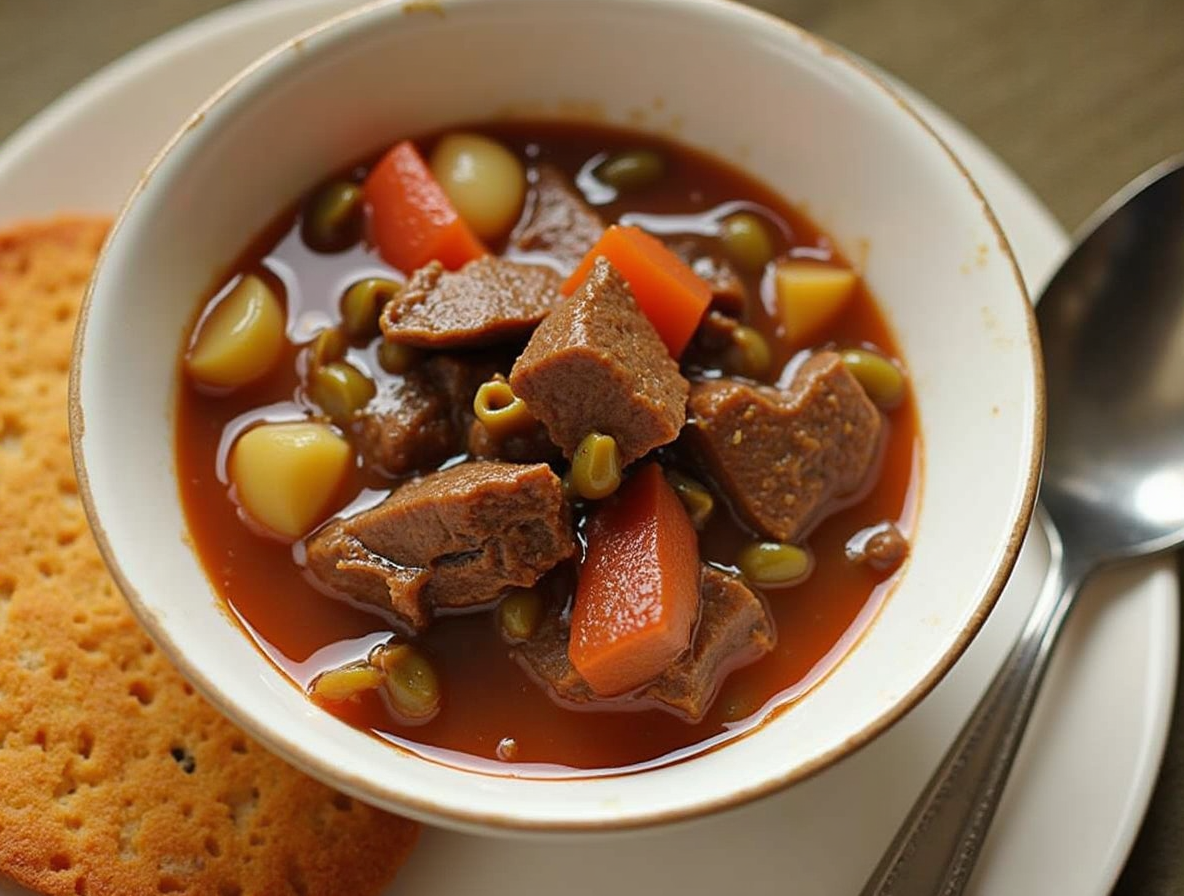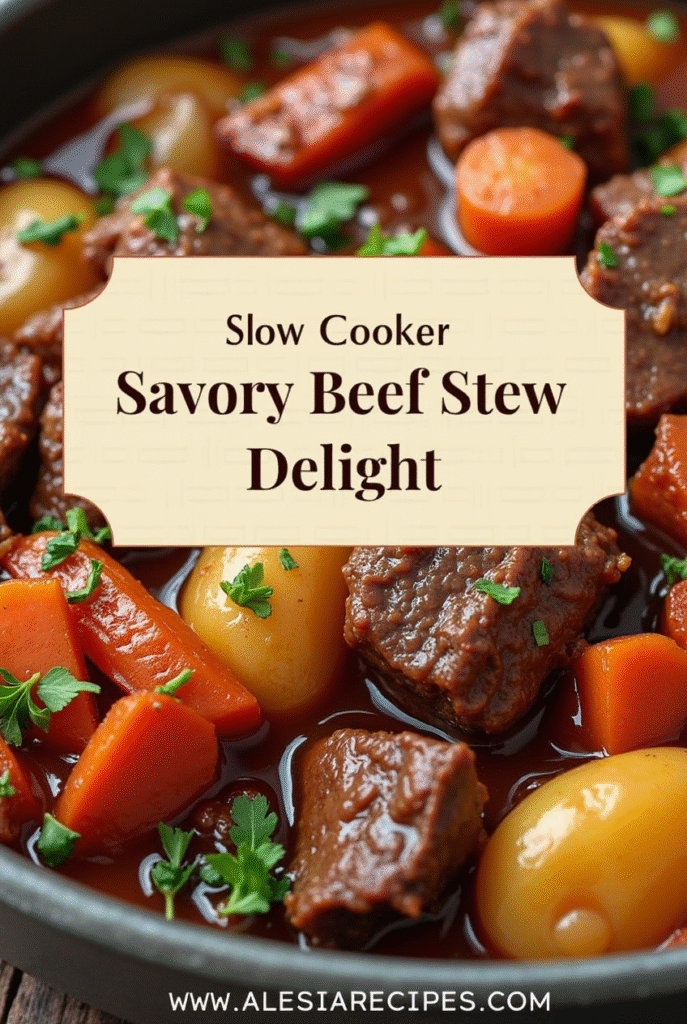The Foolproof Guide to Perfect Savory Beef Stew (Slow Cooker Recipe)
Savory beef stew slow cooker recipes transform even the toughest cuts of meat into melt-in-your-mouth perfection during cold weather months. I’ve found that cooking chuck roast on low for 7-8 hours breaks down the connective tissue, creating that “stick to your ribs” dinner my family requests repeatedly throughout winter.
This hearty beef stew slow cooker method isn’t just convenient—it’s actually the secret to developing deep, complex flavors. In our best slow cooker beef stew recipe, we combine well-marbled beef with potatoes, carrots, onions, and celery, then enhance everything with dry red wine, Worcestershire sauce, and balsamic vinegar. Additionally, a blend of dried herbs like parsley, oregano, thyme, basil, rosemary, and sage creates a savory beef stew crock pot meal that’s both affordable and impressive. Whether you’re meal prepping or feeding a hungry family, this savory beef stew recipe slow cooker approach delivers approximately 576 calories of pure comfort per serving, with 44g of protein to keep you satisfied.
Choosing the Right Ingredients for a Hearty Stew
The foundation of any savory beef stew slow cooker recipe begins with selecting ingredients that transform during long, slow cooking. Making smart choices ensures your stew develops deep flavors and perfect textures.
Best cuts of beef for slow cooking
Chuck roast stands out as the premier choice for hearty beef stew slow cooker recipes. This well-marbled cut contains the perfect amount of fat and connective tissue that breaks down during slow cooking, resulting in fall-apart tender meat. Other excellent options include boneless short ribs for richer flavor, brisket for juicy results, and 7-bone chuck roast which is identified by its distinctive bone shape and ideal for slow-cooking.
Avoid leaner cuts like sirloin, which become tough and chewy rather than tender when slow-cooked. The key is choosing meat with visible marbling – those white veins of fat that melt during cooking to create incredible flavor.
Vegetables that hold up well in the crock pot
For the best slow cooker beef stew recipe, select vegetables that maintain their structure over hours of cooking:
- Waxy potatoes like Yukon Gold or red potatoes hold their shape better than starchy russets, which tend to fall apart
- Carrots add natural sweetness – smaller varieties offer more flavor while larger ones contribute to thickening
- Pearl onions provide texture and flavor, though regular chopped onions work well too
- Celery adds aromatic depth without disintegrating
For best results, cut root vegetables into larger chunks so they cook through without becoming mushy.
Flavor boosters: Worcestershire, balsamic, and herbs
The secret to a truly savory beef stew crock pot creation lies in these flavor enhancers:
Worcestershire sauce provides umami depth that makes the stew taste more “meaty”. Balsamic vinegar adds tang and subtle sweetness that balances the richness. Fresh herbs like thyme and rosemary hold up well during long cooking, while parsley works best added near the end for brightness.
For dried herbs, consider a blend like Herbs de Provence, which combines thyme, basil, rosemary, tarragon, savory, marjoram, oregano, and bay leaf.
Optional add-ins: wine, tomato paste, or beer
Elevate your savory beef stew recipe slow cooker results with these powerful additions:
Dry red wine (Cabernet Sauvignon, Merlot, or Pinot Noir) enhances and extracts alcohol-soluble flavors from other ingredients. Tomato paste, when cooked with oil before adding liquid, contributes rich umami and sweetness. Dark beer, particularly Guinness or other stouts, introduces roasted malt flavors with hints of chocolate and coffee.
These liquid additions not only build flavor but also help break down tough meat fibers for ultimate tenderness.
Step-by-Step: How to Make Savory Beef Stew in a Slow Cooker
Creating the perfect savory beef stew in your slow cooker involves four crucial steps that transform simple ingredients into a rich, comforting meal.
1. Sear the beef for extra flavor
First, pat your beef chunks dry with paper towels. Next, coat them with flour, salt, and pepper by either tossing in a large zip-top bag or mixing in a bowl. Subsequently, heat oil in a skillet over medium-high heat and brown the meat in batches – about 45 seconds per side. This step is non-negotiable; searing develops a caramelized crust that locks in juices and creates deep flavor that can’t be achieved any other way.
Don’t skip the browning step! Furthermore, once the meat is transferred to your slow cooker, deglaze that same skillet with a bit of broth or wine, scraping up those flavorful browned bits to add to your stew.
2. Layer ingredients in the right order
The order matters significantly in slow cooker recipes. Place your seared beef at the bottom of the cooker, closest to the heat source. Above all, add carrots next, followed by potatoes on top. This strategic layering ensures the meat becomes fall-apart tender while preventing vegetables from overcooking and turning mushy.
After layering, resist the urge to stir! Indeed, setting it and forgetting it works best for slow cooker stews.
3. Set the right temperature and time
For optimal results, cook your hearty beef stew slow cooker recipe on LOW for 7-8 hours or HIGH for 3½-4½ hours. Specifically, the stew is done when the meat is fork-tender and vegetables are thoroughly cooked. LOW setting typically produces more tender meat, hence making it the preferred choice whenever time permits.
4. Add thickener and peas at the end
About 30 minutes before serving, it’s time to thicken your savory beef stew crock pot creation. Create a slurry by whisking together 1-2 tablespoons cornstarch with cold water, or mix equal parts flour and softened butter. Stir this into the hot stew and continue cooking with the lid off.
Add frozen peas during the final 10-15 minutes of cooking—they need just enough time to warm through without becoming mushy.
Tips to Make It Foolproof Every Time
Mastering a few critical techniques transforms an ordinary savory beef stew slow cooker recipe into a guaranteed success every time. Applying these proven methods ensures consistently delicious results with minimal effort.
Use the low setting for tender meat
The slow cooker’s low setting produces noticeably more tender meat. Cooking on low for 6-8 hours allows collagen to break down properly, creating that melt-in-your-mouth texture we crave in hearty beef stew. Conversely, the high setting reaches the same final temperature but too quickly, potentially causing meat to become tough rather than tender. If you’re pressed for time, remember that 1 hour of stovetop simmering equals approximately 5-6 hours on low or 2-2.5 hours on high in a slow cooker.
Don’t skip the searing step
Browning your meat before slow cooking isn’t optional—it’s essential for the best savory beef stew crock pot results. This step creates a caramelized crust through a Maillard reaction, developing complex flavors impossible to achieve otherwise. Pat the meat dry first, then sear until a dark crust forms. Moreover, meat browned as whole pieces rather than cubes retains more moisture—as much as 17.5% more compared to pre-cubed meat.
Deglaze the pan for added flavor
After searing, don’t waste those flavorful browned bits (called fond) stuck to the pan. Deglazing captures this concentrated flavor. Pour cold liquid—wine, broth, or beer—into the hot pan while scraping with a wooden spoon. The resulting liquid contains intense flavor compounds that would otherwise be lost. This simple step adds remarkable depth to your savory beef stew recipe slow cooker creation.
Avoid overloading with liquid
Unlike traditional cooking, slow cookers need approximately half the liquid of regular recipes. This happens because the tight-fitting lid prevents evaporation, causing condensation to drip back into your stew. For the best slow cooker beef stew recipe, add just enough liquid to come up 1-2cm from the base—never more than two cups for most recipes. If your stew still looks watery near the end, remove the lid and cook on high for the final 30-45 minutes.
When to add delicate vegetables
Timing matters tremendously with vegetables. Root vegetables like carrots and potatoes go in early but should be cut into larger chunks to prevent mushiness. In contrast, add delicate vegetables like frozen peas during the final 10-15 minutes. For even better texture control, consider briefly sautéing harder vegetables in oil before adding them to your hearty beef stew slow cooker. This helps them maintain structure during the long cooking process.
Serving, Storing, and Reheating Your Stew
Your savory beef stew slow cooker masterpiece deserves perfect pairings and proper storage to maximize enjoyment long after cooking is complete.
Best sides to serve with beef stew
Nothing complements hearty beef stew slow cooker recipes better than crusty bread for sopping up rich broth. Cloverleaf rolls, buttermilk biscuits, or homemade cornbread make ideal companions. For lighter options, consider a crisp salad with apple and cranberry or fresh kale with toasted breadcrumbs to balance the richness.
Root vegetables like roasted Brussels sprouts or caramelized garlic carrots provide excellent contrasts. Alternatively, starchy sides such as creamy mashed potatoes, fluffy rice, or polenta with balsamic glaze create a truly satisfying meal.
How to store leftovers properly
Following cooking, cool your savory beef stew recipe slow cooker creation to room temperature first, yet never leave it sitting out longer than two hours. Afterward, transfer portions to airtight containers and refrigerate promptly. Properly stored stew remains fresh for 3-4 days in the refrigerator.
Some even claim the flavor improves overnight as ingredients have more time to blend together. Nevertheless, with chili and spicy stews, flavors may become muted over time.
Freezing tips for long-term storage
For extended storage, freeze your best slow cooker beef stew recipe in portion-sized airtight containers, leaving about ½-inch headspace for expansion. Label containers with contents and date—frozen stew typically maintains quality for up to 3 months.
Interestingly, starchy ingredients like pasta, rice, and potatoes don’t freeze well, becoming mushy upon thawing. Similarly, dairy products tend to separate. For better results, consider adding these ingredients when reheating instead.
Reheating without losing texture
To reheat refrigerated savory beef stew crock pot leftovers, warm them slowly on the stovetop over medium-low heat, stirring occasionally. For frozen stew, thaw overnight in the refrigerator first.
Throughout reheating, maintain moisture by covering the pot and potentially adding a splash of broth if needed. For best results, reheat to 165°F. Microwave reheating works well for single portions—cover and stir halfway through for even heating.
Conclusion
After making this hearty beef stew slow cooker recipe countless times, I can confidently say it stands as one of the most rewarding dishes for both novice and experienced home cooks. The magic happens when tough, inexpensive cuts transform into melt-in-your-mouth morsels through low, slow cooking. Additionally, the rich flavors that develop during those 7-8 hours simply cannot be rushed.
Remember that success starts with selecting the right ingredients. Chuck roast provides that perfect marbling for tenderness, while sturdy vegetables maintain their integrity throughout cooking. Likewise, those flavor boosters—Worcestershire sauce, balsamic vinegar, and herbs—elevate a simple stew into something truly memorable.
The process itself remains wonderfully straightforward. Searing the meat first locks in flavors, followed by strategic layering and patience during the cooking process. This method allows you to set it and forget it until those final adjustments with thickeners and quick-cooking vegetables.
My family particularly loves this stew on the second day when flavors have melded even further. Therefore, don’t hesitate to make a double batch for easy meals throughout the week. Paired with crusty bread or a simple salad, this savory beef stew creates the perfect comfort food experience during cold weather months.
While other recipes might seem simpler by skipping steps like browning the meat, these small efforts make all the difference between an ordinary meal and an extraordinary one. Your slow cooker does most of the work anyway! The result? A deeply satisfying, protein-rich meal that brings everyone to the table with smiles of anticipation.
You now have all the knowledge needed to create perfect savory beef stew every time. The combination of proper techniques, quality ingredients, and a bit of patience yields consistent results worth sharing. Soon enough, this foolproof recipe will become your go-to comfort food classic, requested time and again by family and friends alike.
FAQs
Q1. What’s the best cut of meat for slow cooker beef stew? Chuck roast is ideal for slow cooker beef stew. It has the perfect amount of marbling that breaks down during slow cooking, resulting in tender, flavorful meat. Other good options include boneless short ribs or brisket.
Q2. How can I make my beef stew more flavorful? To enhance the flavor of your beef stew, use Worcestershire sauce for umami depth, balsamic vinegar for tang, and a blend of herbs like thyme, rosemary, and parsley. You can also add red wine, tomato paste, or dark beer for additional complexity.
Q3. Should I brown the meat before putting it in the slow cooker? Yes, browning the meat before slow cooking is crucial. This step creates a caramelized crust that locks in juices and develops deep flavors that can’t be achieved otherwise. Don’t skip this important step for the best results.
Q4. How long should I cook beef stew in a slow cooker? For optimal results, cook your beef stew on LOW for 7-8 hours or HIGH for 3½-4½ hours. The stew is done when the meat is fork-tender and vegetables are thoroughly cooked. Cooking on LOW typically produces more tender meat.
Q5. What’s the best way to thicken beef stew in a slow cooker? To thicken your beef stew, create a slurry by whisking together 1-2 tablespoons of cornstarch with cold water, or mix equal parts flour and softened butter. Stir this into the hot stew about 30 minutes before serving and continue cooking with the lid off.


